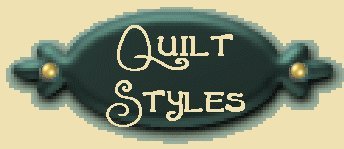| Album
Quilt 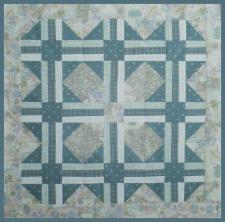
Pattern
|
Album
quilts originated in the 1800's. These quilts are made up of different
blocks made by a group of friends to present as a special friendship
or memory quilt or for a special occasion. These blocks often
represented images, meaningful to the recipient. The
makers sign the center of their block and add a poem, line or
notation.
The appliqué
versions of these are known as Baltimore Album Quilts.
Album quilts
can also include pieced blocks that are the same, using different
fabrics. The center square is where it is signed.
This can
be a nice wedding gift, with pieced blocks being left out for
guests to sign.
These quilts
are also known as Friendship or Signature quilts.
|
| Amish
Quilt 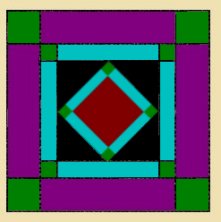
|
Amish
quilts originated in the 1700's by Amish settlers in Pennsylvania.
These quilts
are made with vivid solid colour fabric in deep jewel tones
(red, purple, blue, green) and black. The quilt designs are
of large, very simple geometric shapes (squares, rectangles,
triangles & diamonds).
The quilting
is intricate as the solid fabric showcases the stitches.
|
Baltimore
Album Quilt
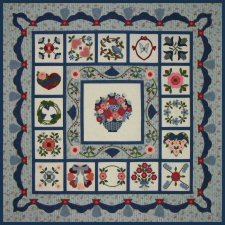
Pattern |
These
date back to the mid 1800's in Baltimore, Maryland. These
album quilts were made using detailed pictorial appliqué blocks
with flora, baskets, wreaths, scenic and historic motifs.
Traditionally
made with white backgrounds and red and green fabrics.
Broderie
Perse was also used.
In the tradition
of album quilts, signatures, poems and dates were noted on the
block.
These are
also known as presentation quilts.
|
| Cathedral
Window Quilt 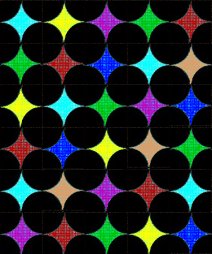
|
Popular
in North America in the 1930's, these quilts are made using a
folded patchwork technique. A
square is folded and blind-stitched in corves to form windows.
A variation
is known as The Secret Garden.

Variation
|
| Celtic
Quilt |
These
quilts use bias strips, appliquéd in a Celtic design. The
basic shapes used are spirals, diamonds, interlace, zigzags
and keys.
|
| Charm
Quilt 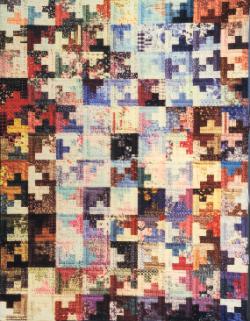
Workshop
+ Pattern |
These quilts
started in the Victorian era, growing from the hobby of collecting
one-of-a-kind buttons on strings, call both charm and friendship
strings.
The
quilter's of the day took this idea, collecting fabrics and making
one patch quilts. Each patch made with a different fabric.
Some of the
lore that goes along with these collections include:
- If a young
lady collected 999 different buttons or fabrics, the 1000th
would be brought to her by her one true love.
- Sometimes
mothers made a charm quilt, duplicating one fabric. Looking
for the duplicate would entertain a sick child.
This type
of quilt is great if you love to collect fabric. A 6" square
of each would be plenty. Some good sources for collecting these
6" charm squares are your friends, guild charm baskets,
magazine ads and our own Charm
Square Swap |
| Classic
Quilts 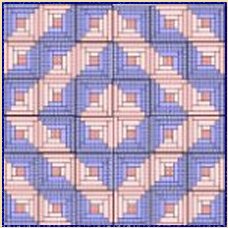
|
This
is large class of quilt. The only criteria is a quilt made from
a traditional block (e.g. Log Cabin, Dresden Plate, Jacob's Ladder,
Nine-Patch, etc.). |
| Contemporary
Quilt 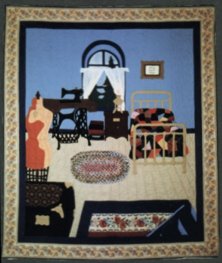
|
Any
types of quilt not using traditional blocks as in Classic
Quilts.
The variety and creativity
is amazing! |
| Crazy
Quilt 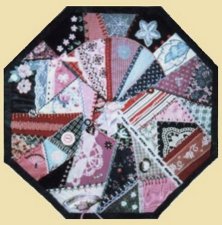
|
This
quilt technique flourished in the Victorian era. Special fabrics
like velvet, silk, satin, taffeta, brocade, wool, etc. were used
in the crazy
patch.
Embellishments
with family keepsakes, lace, beads, buttons, ribbon and of course
embroidery. There is no such thing as too much detail!
|
| Hawaiian
Quilt |
Hawaiian
quilters' have their own long history of quilt making. Influenced
by folk art, their basic appliqué designs reflect elements in
their nature, history and surroundings. The
single layer, paper cut design covers the whole quilt top. It
is achieved by folding the fabric in four or eight and cutting
out the design. It is a lot like snowflakes.
It is then
basted and appliquéd to the background fabric.
|
| Medallion
Quilt 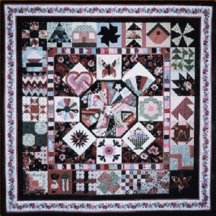
Pattern
|
This
style of quilt making is one of the earliest. The
quilt is identified by the large central motif, surrounded by
blocks and borders that enhance the center.
The design
in the center is usually set straight or on-point with corner
units.
Round Robin
quilts are based on this style. |
Miniature
Quilts
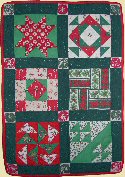
Pattern
|
These
mini quilts are done in traditional block designs, scaled down
to a small size. The
usual measurements for the blocks is 4" or smaller with
the full quilt size being no larger than 24". Dollhouse
miniatures should be 1:12.
These quilts
make nice wallhangings.
This style
is a great way to play with different quilt patterns, without
the time and fabric the larger version would be.
|
| One
Patch Quilt |
This
quilt is made with a single shape patch, repeated throughout the
quilt. Traditional
shapes include apple core, square, rectangle, half-square triangle,
hexagon, equilateral triangle, diamond & clamshell.
Light and
dark fabrics are alternated for a contrasting random design
or patches are laid out before sewing for a planned design.
Charm
quilts
are one patch quilts made with no fabric being used more than
once.
|
| Picture/Photo
Quilt 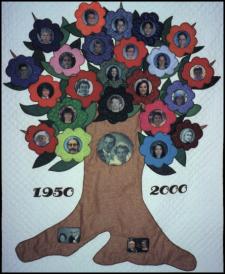
Pattern
|
These quilts can come
in any shape or size...with the photographs, on the quilt, as
the common thread. There are
several techniques to achieve the photo fabric.
You can print photographs, using
your computer, on treated fabric.
There is also photo transfer sheets
(various brands). You print or copy the photographs, onto the
paper. With a very hot iron, you can press these images onto
cotton fabric. |
| Rag
Quilt |
This
type of quilt sews the patches with the raw edges out. After the
quilt is complete, it is washed. The frayed edges of the patches,
that occurs, makes a fuzzy detailing. |
| Sampler
Quilt 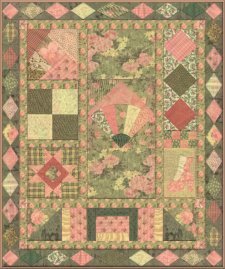
Pattern
|
These
quilts are made of different block patterns. Similar coloured
fabrics and borders help the design become a whole design.
Sampler
quilts are usually taught as a beginner class because the variety
of piecing techniques, the different blocks require, enables
the student to learn basic quilting techniques used in all quilt
making. All with one project. |
| Scrap
Quilt 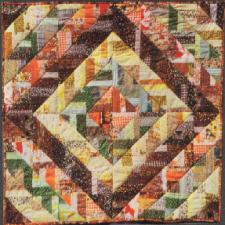
|
This
quilt can be any quilt pattern made with dozens of different fabrics.
It is a
great way to use a lot of smaller scrap cuttings of fabric.
You can
mix all the fabrics or use a planned colour scheme. |
| Seminole
Quilt |
This
quilt style originates from the late 1800's from the Seminole
Indians of Florida. The
technique uses strip sets of usually solid fabric. They are
cut down and set back together by staggering the block, creating
a band of the design.
|
| Stained
Glass Quilt |
These
smaller quilts are made to look like stained glass. Hand dyed
fabrics and bias binding, as your leading, can turn a stained
glass pattern into a quilt pattern. |
| Wagga
Wagga Quilt |
This
historic Australian quilt style was originally done by men (Wagga
Rugs) by sewing grain sacks together. The women also made their
versions with well washed sugar bags. Later,
this quilt was adapted to use woolen suiting samples.
These quilts
can have the look of contemporary art. |

